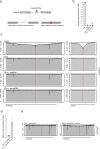Harnessing DSB repair to promote efficient homology-dependent and -independent prime editing
- PMID: 35332138
- PMCID: PMC8948305
- DOI: 10.1038/s41467-022-28771-1
Harnessing DSB repair to promote efficient homology-dependent and -independent prime editing
Abstract
Prime editing recently emerged as a next-generation approach for precise genome editing. Here we exploit DNA double-strand break (DSB) repair to develop two strategies that install precise genomic insertions using an SpCas9 nuclease-based prime editor (PEn). We first demonstrate that PEn coupled to a regular prime editing guide RNA (pegRNA) efficiently promotes short genomic insertions through a homology-dependent DSB repair mechanism. While PEn editing leads to increased levels of by-products, it can rescue pegRNAs that perform poorly with a nickase-based prime editor. We also present a small molecule approach that yields increased product purity of PEn editing. Next, we develop a homology-independent PEn editing strategy, which installs genomic insertions at DSBs through the non-homologous end joining pathway (NHEJ). Lastly, we show that PEn-mediated insertions at DSBs prevent Cas9-induced large chromosomal deletions and provide evidence that continuous Cas9-mediated cutting is one of the mechanisms by which Cas9-induced large deletions arise. Altogether, this work expands the current prime editing toolbox by leveraging distinct DNA repair mechanisms including NHEJ, which represents the primary pathway of DSB repair in mammalian cells.
© 2022. The Author(s).
Conflict of interest statement
M.P., N.A., S.L., S.W,. P.H., D.D., J.B., S.v.d.P., P.M-G., S.Š., G.S., M.F., and M.M. are employees and shareholders of AstraZeneca. B.B. is a former employee of AstraZeneca. M.M. is listed as inventor in an AstraZeneca patent application (WO2021204877A2) related to this work.
Figures





References
Publication types
MeSH terms
Substances
LinkOut - more resources
Full Text Sources
Other Literature Sources
Medical
Research Materials

